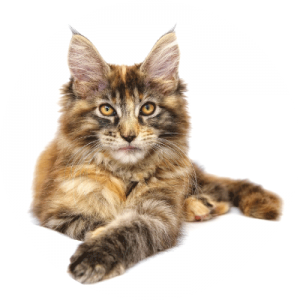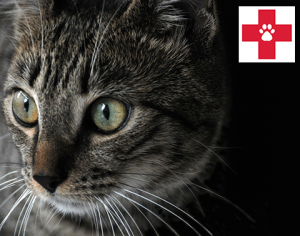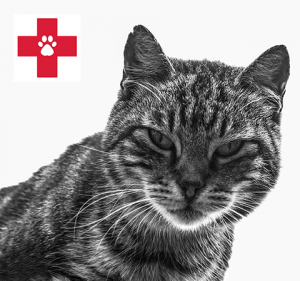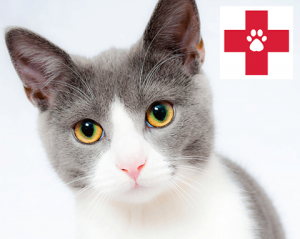HCM is the most common heart disease in cats and stands for Hypertrophic Cardiomyopathy. Although it has occasionally been reported in dogs, this is very rare.
So what actually is it?
HCM describes a condition where the muscle wall of the heart becomes diseased. The walls grow additional layers of muscle, becoming stronger and stronger (which sounds like a good thing). However, this causes two problems – firstly, the space inside the heart (the lumen) is narrowed, meaning that the volume of blood that can be pumped out with each heartbeat is reduced. The second problem is that the thicker heart wall cannot relax properly – so the heart cannot fill effectively between beats. This means that the cat’s heart rate increases, to maintain their blood pressure – but of course, the harder the heart works, the stronger and thicker the muscle becomes.
What causes HCM?
There are three main causes:
- Primary HCM occurs in an otherwise healthy cat. It is the most common form and is thought to be a genetic disease. In some high-risk breeds (Maine Coons and Ragdolls) the exact mutations have been discovered and there are DNA tests that can be carried out, but these aren’t available for most cats.
- Secondary HCM is a response of the heart to another disease process. This may be:
- Hyperthyroidism (an overactive thyroid), the most common secondary cause.
- Hypertension (high blood pressure), usually in turn due to kidney failure.
What are the symptoms?
Most affected cats show no symptoms at all in the early stages of the disease. This is because even though the heart is becoming less efficient, the cat’s body can compensate for the disease, masking the symptoms. In this phase, one of our vets may hear a heart murmur when checking your cat over at vaccination, but there usually aren’t any other signs. However, the condition is progressive, and eventually, they won’t be able to mask it any longer. Some cats progressively develop subtle signs that gradually worsen, but many appear absolutely fine until they suddenly collapse, or even drop dead – this is known as an acute decompensation crisis.
There are two different clinical syndromes associated with HCM:
- Congestive Heart Failure – where the heart can’t pump blood effectively enough, leading to pooling of fluid in the lungs and other organs. Typical symptoms usually appear in more-or-less the following order:
- Heart murmur
- Abnormal heart rate or rhythm
- Increased time spent sleeping
- Less time being active or playing
- Increased breathing rate
- Increased breathing effort
- Pale or blue gums and cold extremities
- Collapse or fainting
- Open-mouth breathing
- Sudden death
- Thromboembolism – the failing heart isn’t pumping blood smoothly through its chambers, and as a result, blood clots start to form within the heart. At any stage, bits of these clots can break off and travel round the body. If they come to rest, they will grow and block an artery, and the symptoms will depend on where this occurs:
- Stroke – where the blood clot blocks blood flow in the brain. Symptoms include fits, collapse, blindness and coma.
- Pulmonary embolism – occurs in the lungs, resulting in very sudden onset difficulty breathing.
- Aortic thromboembolism, also known as a saddle thrombus, is the most common form – it is one of the most common presenting symptoms of a cat with HCM. This occurs because a blood clot has cut off ALL circulation to one or both hind legs, causing extreme pain and paralysis, and is often fatal.
How is HCM diagnosed?
There are two ways the condition can be diagnosed; however, the DNA test is not one of them. This is because some cats who have the mutation don’t develop HCM, while many cats without it do.
A better “screening test” is the proBNP blood test – any cat with a raised proBNP level is likely to have some form of heart disease and needs further investigation.
The “gold standard” for diagnosis, however, is echocardiography, where a vet uses ultrasound to look inside your cat’s heart and measure how thick the wall is and how well their heart is working.
It’s important to remember, though, that just because a cat doesn’t have HCM, it doesn’t mean they’ll never develop the disease – it’s a condition that can develop at any age, and so cats in high-risk breeds should be regularly tested.
Is there any treatment?
Sadly, there is no cure for the genetic form of the disease. Affected cats should never be bred from, and if possible, all Maine Coon and Ragdoll cats should undergo DNA testing before they breed, in case they are carriers of the defective gene. Cats with Secondary HCM, however, can sometimes be returned to almost normal heart function if the underlying disease is detected and treated early enough.
In most cases, medical treatment is required. The mainstays of treatment are:
- Slow down the heart rate – our vets may use drugs such as beta-blockers for this.
- Help the heart relax between beats – a drug called diltiazem is licensed for this purpose in the UK.
- Prevent clots from forming – using human drugs such as aspirin or clopidogrel at specific feline doses on prescription.
- Reduce fluid buildup – ACE-inhbuilduprugs like benazepril and diuretics like frusemide are commonly used to reduce fluid pooling, helping the cat to breathe.
How long can a cat live with HCM?
The prognosis for cats with HCM is very variable – some cats may never develop clinical signs and will live normally for many years. Once symptoms appear, most cats survive less than two years; if the first symptom is a blood clot, the average survival time is only six months. As a result, the best prognosis is thought to be for cats diagnosed early, before symptoms appear!
If your cat is in an at-risk breed, or you are concerned about heart disease, make an appointment to get them checked out by one of our vets. If necessary, they can arrange blood testing or heart scans to see what’s actually going on!



